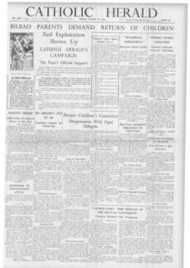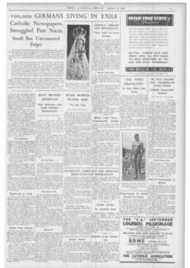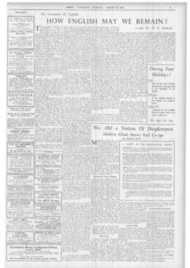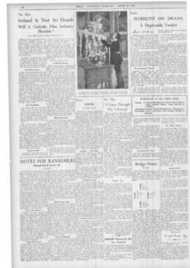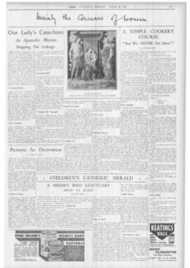Page 15, 20th August 1937
Page 15

Report an error
Noticed an error on this page?If you've noticed an error in this article please click here to report it.
Tags
Share
Related articles
London-cum-kent Dippings Into Pilgrim Pages
Tv -r Ryward Stourton
Holiday Travel Can Sussex Endure ?
Bishops And The Liturgy
Motor Missionaries Say Mass In Pubs
ON RUMBOLD'S HILL An Ancient Sussex Mission
Those who search the Catholic Directory to find the oldest of our outposts of faith in any given county will be pulled up short with interest at the particulars printed in regard to two Sussex centres: West Grin stead, " Pre-Reformation "; Midhurst, " 1558."
West Grinstead comes into the papers, every year, by the pilgrimage to that town in honour of Our Lady, a pilgrimage which itself has by now a respectable antiquity. Midhurst is less thought about, in connection with Catholic doings, by folk unacquainted with those parts; yet a parish which is now in line with nearly 380 years of history is obviously a parish to note and, for its local interest, to visit.
Behind the " Wheatsheaf " Adjoining and partly hidden by the " Wheatsheaf " inn at Midhurst is a small, plain church, the.church of St. Francis' of Assisi. There the faithful of Midhurst and the immediate neighbourhood have their place of worship, a building long over-small for the needs of the congregation. It was opened not far short of seventy years ago, and very proud its pastor and people were of it; for whereas the priest at that time, the Rev. G. F. Ballard, had at first aspired only to an adapted coach-house, benefactors had come forward and enabled him to put up a brand new church, designed by Mr. C. A. Buckler. And since then the Catholic resources of the town have been strengthened, for many years past, by the good work of a community of Sisters of Mercy, who have at Midhurst a school, St. Margaret's, and a training home for servants.
But the opening of the church behind the " Wheatsheaf," on Rumbold's Hill, in 1869, was not, by centuries, the first chapter in the mission story. Midhurst is fortunate in being one of those places which have found a local historian. In this case the historian was a former parish priest, the Rev, H. M. Willaert, whose memory should be held in gratitude by Sussex men
especially. Thanks to Fr. Willaert, there was set down and published, in 1928, a consecutive narrative tracing the fortunes of the Catholic faith in the Midhurst district from the sixteenth century onwards.
In Cowdray Castle
The story begins with the old chapel at now ruined Cowdray, and with the zeal of the Montagues of that famous house up till the unhappy day when the seventh Viscount left the Church, to which he was reconciled
only on his death-bed. The Cowdray chapel no longer served, and the second part of the history transfers itself to the village of Easebournc, where there was erected the first post-Reformation Catholic church in Sussex. It is but fair to the defecting Lord Montague's memory to record that, although he himself had joined the Established Church, and had expelled the Mass from Cowdray, dismantling the chapel, he it was who established the Easebourne centre, which was later kept going by Catholic generosity augmenting the original endowment.
Secularised During nearly ninety years the building at Easebourne served as a chapel; but in 1856, when the lease expired, and after the Cowdray estate had passed into other hands, the new owner, Lord Egmont, would not grant a renewal; what had been a place of worship became the village institute, and its presbytery a caretaker's lodge. On the testimony of some old inhabitants, Fr. Willaert put it on record that in the days when the building was in Catholic hands " the street where the little church stood looked like a fair on a Sunday morning, on account of the number of vehicles of all sizes and shapes that were waiting whilst their owners were at Mass."
At Midhurst
The titular patronage of St. Francis was invoked when Mass began elsewhere, shortly afterwards. This time the altar was
set up at Midhurst, in a room in North Street. When that room failed, by the priest's departure, a curtained wagonette, jokingly dubbed the " flying bedstead," took the faithful remnant of the flock to Burton Park for Mass on Sundays. This was in 1861, and Burton Park received and ministered to these faithful until 1866, when the Feast of St. Francis of Assisi brought a reopening at Midhurst, with the coming of Fr. Ballard to the town. Again, for a time, there was Mass in an improvised chapel in a private house. Fr. Ballard tried to get the Easebourne building back. In this he was not successful; but fortune opened out another opportunity by the announced sale of the stableyard behind the " Wheatsheaf." The site was bought; the church was built; the story has 'gone full circle.
Catholic visitors to Midhurst today, even it their stay lasts but an hour, should make a point of visiting the little church on Rumbold's Hill. The bdilding may have but small interest for them in the matters of architecture and furnishing; but apart from the transcendental thought of the Presence, they will find there a link, as has been shown, with the far-off days when Cowdray Castle kept both faith and altar, and this for some two hundred years during the Penal Times.
The present number of Catholics in the parish is about 180; the church holds fewer than seventy. It is edifying, but on other grounds inconvenient, that Sunday nowadays brings the spectacle, at both Masses, of a congregation so large that a number of persons have to stand in the only aisle. In his lifetime Fr. Willaert secured the site for a new church. The faithful of Midhurst and Easebourne look forward to the day when it will be possible for them to worship in a building large enough for their
needs and worthy of their traditions. If outside generosity supplements their own efforts, that hope may, perhaps, be realised.
blog comments powered by Disqus


